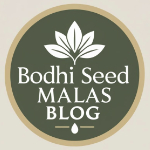The best Bali villas to truly unwind
(and turn your bodhi-seed practice into a daily ritual)
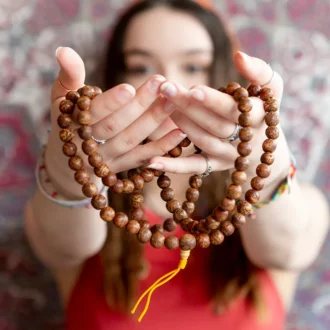
Bali’s quiet corners make it easy to slow down: dawn birdsong, incense on the breeze, and long, unhurried mornings with your mala. Below are handpicked villas where you can genuinely relax and keep a steady bodhi-seed (rudraksha-style) rhythm—plus my featured pick in Seminyak.
How to choose a “bodhi-friendly” villa
- Dedicated space: a deck, pavilion, or shala where you won’t be interrupted.
- Soft soundscape: rice fields, jungle gullies, or high clifftops.
- On-site support: staff who can arrange gentle extras (in-villa meals, yoga teachers, drivers) so you can stay present.
- Walkability/quiet access: close to beach or nature, but away from late-night noise.
Featured: Villa Kinaree Estate — your calm base among the Seminyak villas
A rare find in Bali, is actually one of the top Seminyak villas called Villa Kinaree Estate is actually two adjoining villas that combine into a 7–10 bedroom private estate with two pools, expansive living areas, and a full-time team. It sits in the Oberoi pocket—tucked away down a quiet lane—so you can slip to the beach or cafés when you want, then retreat to privacy when you don’t. For a bodhi-seed routine, the broad pool decks and open living pavilions make effortless morning mala rounds, breathwork, or a short metta sit before breakfast.
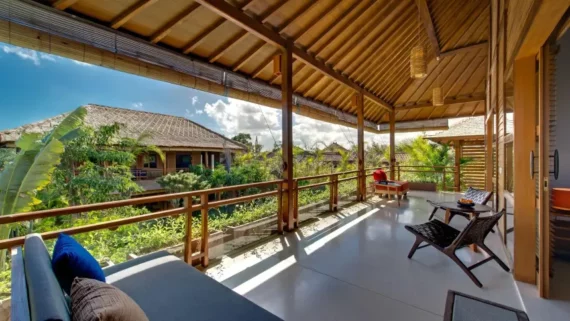
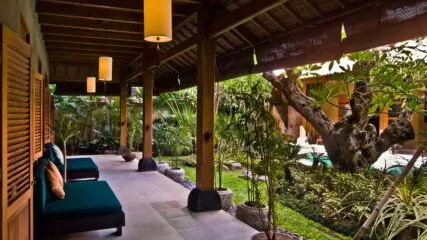
Why it works for practice
- Spacious common areas for group meditation or gentle asana.
- Two pools and gardens that naturally “lower the volume.”
- Central location for sunset beach walks without sacrificing quiet back at home base.
Ubud: rainforest hush and rice-field stillness
Villa Vajra (Sebali, near Ubud)
Perched above a forested gorge, Villa Vajra is purpose-built for contemplation—think open pavilions, river sounds below, and an outdoor platform perfect for seated practice. If you prefer a nature track to a nightlife scene, this is your lane.
(Area pick) COMO Shambhala Estate (for day passes or splurge stays)
If your group wants the full wellness “cocoon,” COMO’s jungle estate offers yoga pavilions, hydrotherapy pools, and personalized programs; even if you don’t overnight, their facilities and experiences are worth planning a dedicated practice day around.
Seminyak: practice first, coffee later
Villa Yoga (7BR, private shala)
A favorite for small retreats: 7 bedrooms, a 25m pool, and a dedicated open-air yoga studio right by the garden—ideal for mala counting at sunrise and a slow vinyasa after. You’re close to shops and cafés, but the internal garden keeps things serene.
Canggu: eco-calm with studio access
Desa Seni, A Village Resort
Canggu’s beloved eco-village pairs antique wooden homes with an on-site yoga center and organic ethos. Between classes, you can journal by the pool or take your beads to a shady nook in the gardens.
Uluwatu: cliff-top clarity
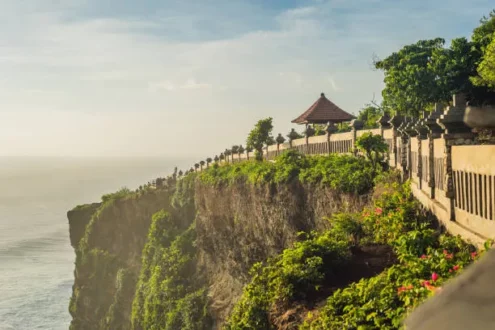
Alila Villas Uluwatu
Minimalist lines, private pool villas, and endless ocean horizon. The semi-open cabanas and villa terraces are perfect for sitting practice and breathwork; evenings bring quiet, salty air and huge skies.
The Edge
For those who want postcard-level drama with meditative mornings, The Edge’s clifftop villas and “sky pool” deliver. Do your rounds at first light, then let the day stretch out.
A simple bodhi-seed routine you can keep anywhere
- Ground (2–3 minutes): sit, feel the seat and the breath.
- 108 rounds: move one bead per breath or mantra; if you lose count, smile and keep going.
- Walk in silence (10–15 minutes): rice-field path, beach, or garden loop.
- Close with gratitude: one breath per family member or intention.
Packing tip: bring a small cloth pouch for your mala, plus a light shawl—you’ll use both for cool mornings and temple visits.
How to pair these picks with your trip
- Want central access + privacy? Make Villa Kinaree Estate your base, then add a day trip to Ubud for temple time. (Villa Kinaree Estate)
- Design-driven solitude? Split nights between Alila Uluwatu and an Ubud hideaway like Villa Vajra.
- Group retreat vibe? Book Villa Yoga for the shala and length-of-garden pool; schedule a drop-in morning at Desa Seni. (villa-bali.com)
If you want, I can tailor this into a publish-ready blog page in your site’s voice (title tags, meta description, internal links, and a hero image), and weave your Seminyak villas feature more prominently across headings and captions.
The Best Kinds of Bodhi Seed Malas
Mala beads have long been used as sacred tools for meditation, prayer, and spiritual connection. Among them, Bodhi seeds malas hold a special place in the hearts of practitioners — not just for their deep spiritual symbolism, but for their grounding texture and natural beauty. But did you know there are different kinds of Bodhi seed malas, each with its own unique qualities?
In this post, we’ll explore the best kinds of Bodhi seed malas, how to recognize them, and what makes each type special.
Traditional Bodhi Seed Malas
This is the classic variety, often sourced from the Bodhi tree species Ziziphus or Elaeocarpus. These seeds are typically round with a smooth surface and a naturally dotted pattern — each “eye” or spot represents spiritual insight.
Why we love it:
-
Traditionally used by monks and serious practitioners
-
Develops a beautiful patina over time
-
Grounding and comforting to hold
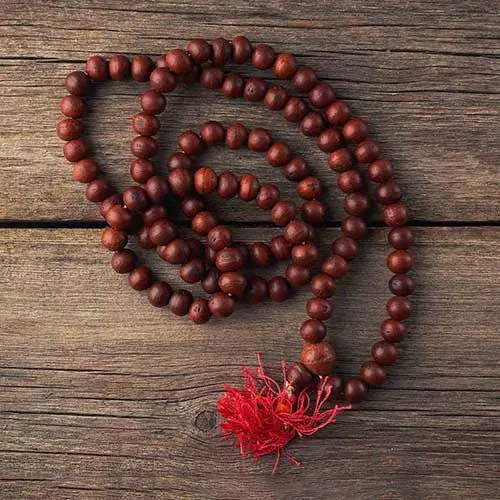
Phoenix Eye Bodhi Seeds
These seeds are named for the “eye” marking on each bead, resembling the eye of a phoenix. They are very popular in Tibetan Buddhism and are thought to offer spiritual protection and clarity of mind.
Why we love it:
-
Unique markings give each bead character
-
Highly prized in Himalayan traditions
-
Durable and often paired with turquoise or coral spacers
Lotus Root Bodhi Seeds
Despite the name, these aren’t from the lotus plant. Instead, they come from the wild date tree. Their lighter color and smooth surface make them a favorite for those who enjoy a clean and elegant look.
Why we love it:
-
Smooth, polished finish
-
Lightweight and easy to wear
-
Great for modern or minimalistic styles
Moon and Star Bodhi Seeds
These beautiful seeds are named for the tiny star and moon-like markings on their surface. Often cream or ivory in color, they are seen as auspicious and connected to cosmic energy.
Why we love it:
-
Stunning visual patterns
-
Symbolic of balance between light and darkness
-
Often used in high-quality, artisan malas
Mini Bodhi Seed Malas
For those who prefer something smaller and more discreet, mini Bodhi seed malas offer all the benefits of full-size malas in a more compact form. Ideal for everyday wear or travel.
Why we love it:
-
Lightweight and portable
-
Still powerful in intention and energy
-
Easy to layer with other bracelets or necklaces
Final Thoughts
When choosing a Bodhi seed mala, there’s no single “best” kind — it depends on your personal connection, intention, and aesthetic preference. Some people are drawn to the rugged energy of phoenix eye seeds, while others prefer the soft elegance of lotus root or moon & star varieties.
Whatever type you choose, know that a Bodhi seed mala is more than a spiritual tool — it’s a companion on your journey toward mindfulness, compassion, and self-awareness.
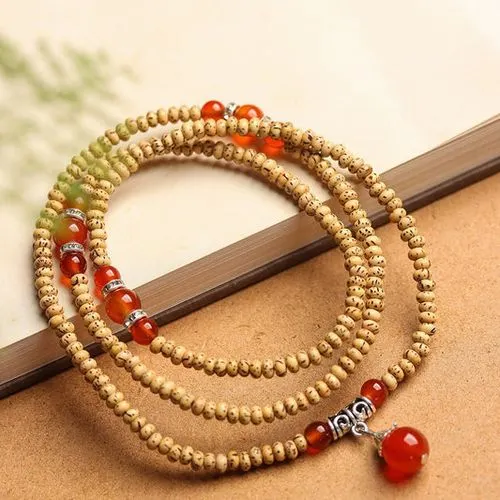
Where Do Bodhi Seeds Come From?
If you’ve ever held a Bodhi seed mala, you’ve likely felt its grounding energy and deep spiritual resonance. But have you ever wondered where these sacred seeds actually come from?
Despite their name, not all Bodhi seeds come from the actual Bodhi tree (Ficus religiosa) — the legendary tree under which the Buddha attained enlightenment. In fact, “Bodhi seed” is a term that refers to several types of seeds used in spiritual malas, all carrying the essence of awakening, mindfulness, and devotion.
In this post, we’ll explore the origins of Bodhi seeds, the plants they come from, and how they’ve become cherished across spiritual traditions.
1. The Original Bodhi Tree (Ficus religiosa)
Let’s begin with the true Bodhi tree — a type of fig tree native to India, Nepal, and Sri Lanka. Known as the “Tree of Awakening”, this is the very species under which Siddhartha Gautama meditated and attained enlightenment over 2,500 years ago.
Do malas come from this tree?
Not typically. The seeds from Ficus religiosa are small and not well-suited for stringing. While leaves and bark from this sacred tree may be used in religious offerings, malas labeled as “Bodhi seed” usually come from other species.
2. Phoenix Eye Bodhi Seeds (Ziziphus or Wild Date Trees)
One of the most popular types of Bodhi seed malas comes from the Ziziphus family — often called “Phoenix Eye Bodhi” due to the eye-shaped markings on each bead.
These seeds are commonly sourced from Tibet, Nepal, and parts of India. The trees produce hard, round seeds that are ideal for malas and naturally feature the symbolic “eye” that represents spiritual awakening and insight.
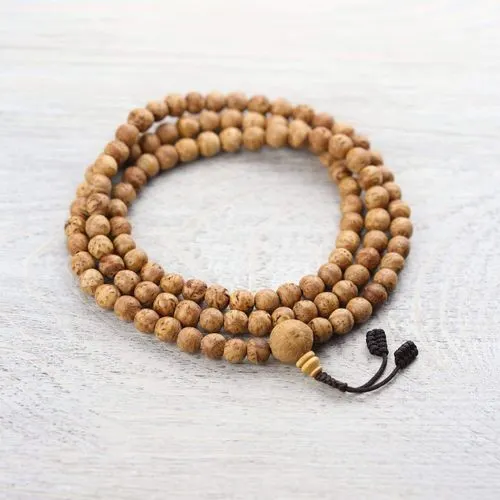
3. Lotus Root and Moon & Star Bodhi Seeds
Despite their poetic names, these beads do not come from the lotus plant or the moon. These seeds often come from species of wild date trees, palms, or other flowering shrubs found in China, Nepal, and Southeast Asia.
-
Lotus Root Bodhi Seeds: Known for their smooth, cream-colored surface, these are popular for their elegant look.
-
Moon & Star Bodhi Seeds: Named for the dotted star and crescent patterns on each bead, they are prized for their unique visual appeal.
4. Chinese and Himalayan Sources
Many Bodhi seed malas, especially those used in Tibetan Buddhism, are sourced from highland regions in Tibet, Nepal, and Bhutan, where mala-making is a deeply rooted tradition. China is also a major source, especially for intricately carved or polished Bodhi beads, often used in more decorative or symbolic malas.
Why It Matters
Understanding where your Bodhi seeds come from adds meaning to your practice. Whether your mala is crafted from Tibetan Phoenix Eye seeds or Himalayan Moon & Star seeds, each bead carries a story — of land, tradition, and the human intention to seek awakening.
Closing Thoughts
Bodhi seeds may come from different trees and regions, but they all share one purpose: to support your spiritual journey. Each time you turn a bead in your hand, you’re connecting not just with your breath or mantra, but with a centuries-old lineage of seekers who’ve walked the path before you.
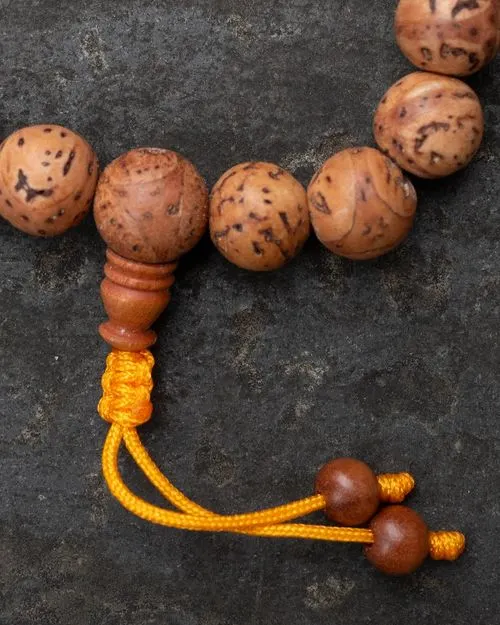
The Spiritual Power of Bodhi Seed Malas
In a world filled with noise, distraction, and constant movement, many people are rediscovering the value of ancient spiritual tools to reconnect with their inner selves. Among these tools, the Bodhi seed Japamalas holds a revered place — not just as a meditation aid, but as a powerful symbol of spiritual growth and awakening.
In this post, we explore the spiritual points and deeper meanings of Bodhi seed malas and how they can support your practice and path.
1. Awakening and Enlightenment
The word “Bodhi” means awakening or enlightenment in Sanskrit. It refers to the profound realization attained by Siddhartha Gautama when he meditated beneath the Bodhi tree over 2,500 years ago.
Wearing or using a Bodhi seed mala is a symbolic way of walking the path of the Buddha — of committing to mindfulness, compassion, and spiritual insight.
Spiritual Point:
A Bodhi seed mala is a constant reminder of your potential for awakening.
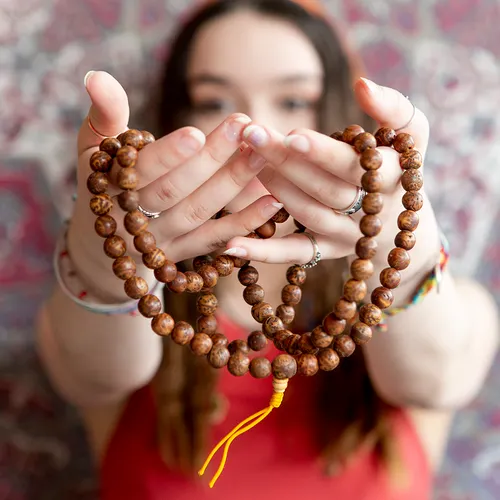
2. Sacred Connection to Nature
Each Bodhi seed is a natural element — grown, formed, and shaped by the earth. Carrying it is like carrying a small piece of the living world with you. Unlike synthetic or metal beads, Bodhi seeds feel warm and organic, grounding you in the present moment.
Spiritual Point:
The seeds represent our deep connection to nature and the cyclical rhythms of life and growth.
3. A Tool for Mindful Repetition
Whether you’re chanting a mantra, reciting prayers, or simply counting breaths, a mala helps you stay focused. Moving bead by bead brings you into the here and now — each seed acting as an anchor for your awareness.
Spiritual Point:
The mala becomes a sacred guide, helping you turn inward, quiet the mind, and cultivate stillness.
4. Protection and Energy Clearing
Many spiritual traditions believe that Bodhi seeds absorb and hold spiritual energy. As you use your mala regularly, it becomes imbued with your intentions, prayers, and vibrations — essentially becoming a personal energy field that offers protection and grounding.
Spiritual Point:
Your mala is more than a tool; it becomes a spiritual companion, holding and amplifying your energy.
5. Symbol of the Journey
Each mala typically has 108 beads — a sacred number in Buddhism, Hinduism, and other traditions. It represents the universe, the chakras, the mantras, and the steps toward liberation.
Spiritual Point:
Using a Bodhi seed mala symbolizes a full spiritual journey — one that honors discipline, devotion, and the quest for inner truth.
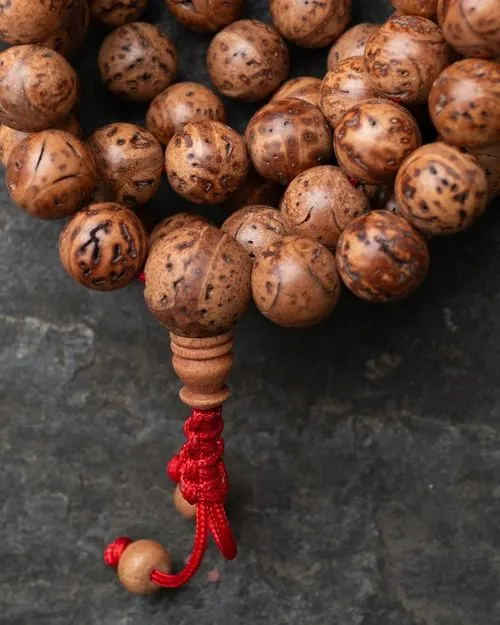
6. Cultivating Intention
Many people use Bodhi seed malas for setting intentions, whether it’s healing, clarity, love, or strength. The natural texture of the beads invites slow, deliberate use — perfect for intention-setting rituals or meditation.
Spiritual Point:
Each bead becomes a vessel for your deepest intentions and spiritual goals.
Final Thoughts
A Bodhi seed mala is more than a necklace or bracelet — it is a sacred tool, a symbolic compass, and a spiritual companion. Whether you wear it, meditate with it, or carry it in your pocket, your mala reflects your inner journey and invites you back to your highest self.
